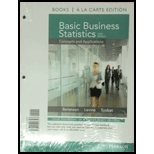
Concept explainers
Given a standardized
a.
The probability that
Answer to Problem 1PS
The required probability is 0.9417.
Explanation of Solution
The Table E.2 given in the Appendix of the book provides the area under the cumulative standardized normal distribution from
From the table, the cumulative probability corresponding to the value 1.57 is 0.9418, which can be written as:
Thus, the probability is 0.9417.
b.
The probability that
Answer to Problem 1PS
The required probability is 0.0329.
Explanation of Solution
The probability that
From the table E.2, the cumulative probability corresponding to the value 1.84 is 0.9671, which can be written as,
Substituting the value in the above equation, the required probability is obtained as:
Thus, the probability is 0.0329.
c.
The probability that
Answer to Problem 1PS
The required probability is 0.0254.
Explanation of Solution
The probability that
From the table E.2,
Thus, the probability is 0.0254.
d.
The probability that
Answer to Problem 1PS
The required probability is 0.9746.
Explanation of Solution
The probability that
From part (a) and (b), it is obtained that
Thus, the probability is 0.9746.
Want to see more full solutions like this?
Chapter 6 Solutions
Basic Business Statistics, Student Value Edition (13th Edition)
- The following data represent total ventilation measured in liters of air per minute per square meter of body area for two independent (and randomly chosen) samples. Analyze these data using the appropriate non-parametric hypothesis testarrow_forwardeach column represents before & after measurements on the same individual. Analyze with the appropriate non-parametric hypothesis test for a paired design.arrow_forwardShould you be confident in applying your regression equation to estimate the heart rate of a python at 35°C? Why or why not?arrow_forward
- Given your fitted regression line, what would be the residual for snake #5 (10 C)?arrow_forwardCalculate the 95% confidence interval around your estimate of r using Fisher’s z-transformation. In your final answer, make sure to back-transform to the original units.arrow_forwardCalculate Pearson’s correlation coefficient (r) between temperature and heart rate.arrow_forward
 Glencoe Algebra 1, Student Edition, 9780079039897...AlgebraISBN:9780079039897Author:CarterPublisher:McGraw Hill
Glencoe Algebra 1, Student Edition, 9780079039897...AlgebraISBN:9780079039897Author:CarterPublisher:McGraw Hill
